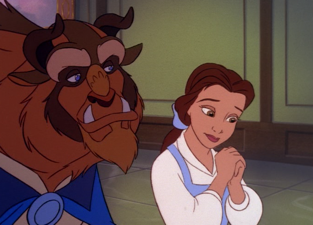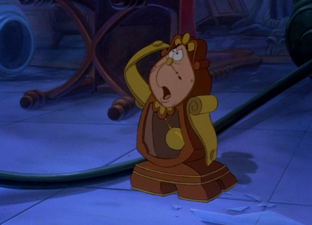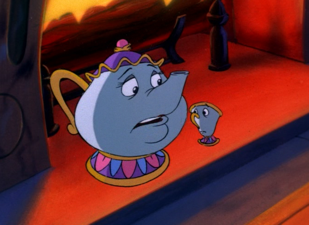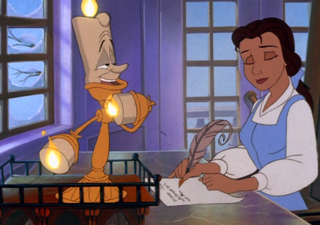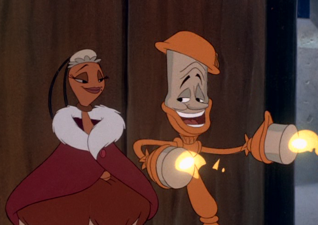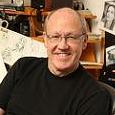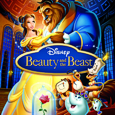DisneyToon Studios (1998), Walt Disney Studios Home Entertainment (2011), 1 discs, 92 mins. plus supplements, 1.33:1 ratio, Dolby Digital 5.1, Rated G, Retail: $29.99
Storyboard:
Did you ever wonder what adventures Belle had in the enchanted castle before the Beast transformed back into a human? In these animated adventures, Belle, the Beast, and the enchanted servants learn how to get along, while the enchanted servants have their own lessons to learn about friendship and love.
The Sweatbox Review:
Midquels movies can either be a good thing or a bad thing. Studios make them to churn out a few more bucks from a successful enterprise before it fades to the wayside. Beauty and the Beast was one of the two movies that brought the wavering studios from its 1980s slump (for your trivia buffs out there, the other film was The Little Mermaid). The animation was spectacular, there was true love, the songs were creative and fun to sing, and it was nominated for an Oscar. Flash forward a few years and Disney had a winning streak akin to Pixar and the Mouse was releasing afternoon TV cartoons of their prize-winning movies: Aladdin, Adventures of the Little Mermaid, Hercules, and Timon and Pumbaa. Beauty and the Beast was missing from this line-up, but the direct-to-video sequels weren’t. First there was Beauty and the Beast: The Enchanted Christmas, then came Belle’s Magical World. The Enchanted Christmas entertained the younger crowds and explored Belle’s life at the castle more than the original film. Belle’s Magical World was supposed to do the same, but instead of a feature-length film we’re treated to half-hour snippets that would have been better produced as a TV series.
Now before we continue, let’s stand back and take a look at the intended audience: elementary school children. These kids love Disney for the pure entertainment value and the characters, most don’t have the world experience to judge a story’s content based on pure originality yet since everything is still new. Keep that grain of salt between your fingers as you watch Belle’s Magical World. There are four half hour episodes starring the entire cast of the original movie, plus three new, enchanted objects that fit in, but lack true development: Webster the Dictionary, LePlume the Quill Pen, and Crane the Parchment. Each episode places the crew in a situation where they learn a life lesson. While the messages are quite apparent to older viewers, the younger crowd will find them just as another piece of the plot they absorb and don’t notice.
In the first episode “The Perfect World,” Belle meets Webster, who enjoys spouting off his verbose language skills and Belle brings him to dinner with the Beast. Belle tells the Beast about the latest book she just read, Cinderella (makes you wonder about the intricacies of the Disney universe), but he can’t concentrate on their conversation because the room gets too warm for his liking. They break out into an argument with Webster adding his two cents, worsening the tension. Belle and the Beast refuse to speak with each other, so Webster enlists the help of LePlume and Crane to help him write fake apology letters, only making things ever more worse. In the end, Belle and the Beast work out their differences and learn the value of forgiveness.
In the second part “Fifi’s Folly,” the French feather duster Fifi is given more screen time than she has ever received. It’s the fifth anniversary of Lumiere and Fifi’s first date. Lumiere is nervous about telling Fifi about his feelings, so Belle offers to help him prepare for the special evening. Fifi sees Lumiere rehearsing a speech about true love to Belle and she jumps to the conclusion that Belle is stealing the candlestick from her. To retaliate, Fifi tries to seduce Cogsworth and upstage Belle. Her plans don’t work and only place her and Lumiere in mortal danger, but Fifi learns that you shouldn’t assume things.
In “Mrs. Potts’ Party,” the British teapot is depressed about the wintery weather. She mentions how it’s an attribute in her family to be down when the weather is gray and when Mrs. Potts is unhappy so is the rest of the castle. Belle decides to throw her a surprise party, but Lumiere and Cogsworth vie to have their own personal plans beat out the other. Eventually their bickering ruins the entire party planning process, making Mrs Potts even more upset. The clock and candlestick end up putting aside their rivalry to make Mrs. Potts feel better, learning that cooperation brings people together. In the last episode, “The Broken Wing,” Belle finds a wounded bird and nurses him back to health. Belle pays more attention to the bird than the Beast, angering him until he hears the bird sing. The Beast decides to keep the bird in a cage a la The Emperor and the Nightingale to keep singing for him, but he realizes the bird won’t sing unless he’s free nor will he respect him—which is also the episode’s lesson.
There are a few unmemorable songs spliced between the morality teachings. They don’t have the same ZING and WOW as the soundtrack from the first movie. Much like the scripts for each Belle’s Magical World episode, they lack creativity and even the target audience will start squirming in their seats once they come on. For the overall movie, the kiddies will enjoy it despite the episodes contain the same plotlines any cartoon fanatic will have seen many times before. It has their favorite Beauty and the Beast characters and it answers the question: “what happened before the Beast changed back into a human?”
My biggest quip with Belle’s Magical World is that it takes animation gimmicks directly from the original movie without shame, as if the animators were required to put them in so the kids would recognize this as Disney’s Beauty and the Beast. The beast roars the same “Get out!” line over a minor infringement, the wardrobe is overly exheurberant, and Belle recites lines she has spoken before. I thought Disney left this trick behind in the 1980s (remember how they reused animation for many of their movies), but they reseurrecacted it to fill screen time here.
Belle’s Magical World isn’t a prime example of Disney’s direct-to-video empire, but it’s not the worst. Kids will like it, but if you have a talking dictionary like Webster, go and read definitions for the length of the film.
Is This Thing Loaded?
While the DVD is decked out in special features, one is hesitant to call them “special.” Half of the features are advertisements for Disney products and the other half are as bland as the morality issues preached in the main presentation. Keeping that in mind, the two main advertisements star former Disney stars Cole and Dylan Sprouse from the Suite Life on Deck for and the other is about how you can watch your Disney DVDs anywhere with digital copies. I give Disney credit for attempting to make these bonus commercials entertaining, but even the intended child audience will see through the money making scheme.
We move onto “Disney’s Song Selection,” which is basically a DVD scene selection menu for all of the songs. You can easily access them through the official scene selection option on the main menu as well, except you’re not encouraged to sing along.
“Belle’s Beautiful Dinner Game” is really boring. You search for the characters Le Plume, Webster, and Crane in four different rooms decorated like a child went to town on a Beauty and the Beast coloring and sticker book. Once you find the trio, Belle writes a note inviting the Beast to dinner and then you answer trivia questions to light a chandelier. At the end, you’re not even invited to the party. I suspect a Disney programmer was asked to throw this together in an afternoon to meet a deadline. A young child might find it entertaining for five minutes, but then move onto something a whole lot more interesting.
When I first saw the “Enchanted Environment” feature, I thought viewers would be allowed to explore the Beast’s castle in poorly rendered CGI with a narrator explaining a room’s significance. After I selected the option, the faraway shot of Beast’s castle from the first movie popped on the screen. I tried to navigate through the forest, instead I was greeted by nature sounds and music. It’s an HD screen saver for your TV that goes through the four seasons to canned music and generic bird songs. Out all the features specifically made for this DVD, the enchanted screen saver is the best, but the animation is the equivalent of the Windows 95 era.
The hidden gem on the disc is an episode of Disney’s Sing Me a Story With Belle, a 1996 live-action series, which can be described as Disney’s answer to Reading Rainbow. Lydnsey McLeod portrays Belle in her quiet, village home where she owns a bookshop. Kids come to her shop everyday to hear Belle sing them stories and rhymes, each episode dealt with a character-building lesson. Belle and the children are joined by the beautiful puppets: Harmony the Cat, Lewis and Carol the Bookworms, and Big Book-an early version of Webster that tells stories instead of definitions. The opening sequence of the series has Belle walking through the village animation sequence from the movie with the villager’s usual dialogue replaced with a catchy theme song. I watched this series when it was brand new and the theme song still echoes so many years later. This particular show teaches that a person’s inner self is more important than what is on the outside; Gaston makes a special guest appearance touting his narcissism. Another notable aspect of this show was that each story Belle told used old Disney cartoons, i.e. Silly Symphonies and classic Mickey and Minnie cartoons with Belle singing the plot. I actually enjoyed these thirty minutes more than the main feature.
Ninety percent of the special features will make your eyes glaze over, while the other ten percent will bring back 1990s nostalgia.
Case Study:
For a less than perfect direct-to-DVD movie, Disney gave it the same accessories as a big movie release, at least on the outside. Looking at the DVD from the outside in, the case is housed a sleek and bright cardboard slipcase with an image of Belle and a smiling Beast in the center. Beneath the main couple are Lumiere, Fifi, Cogsworth, Mrs. Potts, Chip, and Webster. The background is the castle and forest in spring with pink and yellow flowers, and butterfly; this whimsical scene could have been pulled straight from the “Enchanted Environment” special feature. Even though this was a low budget production, the cover is artfully rendered and would make a beautiful wall poster. My only compliment is that the Beast is happy and has a little bird perched on his finger. As this movie serves as a midquel, wouldn’t it better serve his character to represent him as the brooding and angry character that he is? Maybe not, since this is intended for children. The movie’s title has the regular gold and cool color concept, in this case purple, and “special edition” races along the top. The back has a specs list detailing the special features and a generic summary about the movie. One scene from each of the four episodes adorn a bookshelf background. The DVD case is an exact duplicate of the slipcase and when opened the special treatment ends. There are some basic advertisements and a plain, gray single disc on the inside. The phrase “don’t judge a book by its cover” comes to mind—it’s pretty, but the inside contents are lackluster.
Ink And Paint:
I’m not too impressed with the animation for Beauty and the Beast: Belle’s Magical World. DisneyToon Studios, the Disney sect responsible for many of the sequels, TV cartoons, and direct-to-video movies, created this less than perfect midquel. Most of DisneyToon Studios’s animation lacks the fine refinement you get from the main Disney Studios with an all too bright color pallet and cutesy character designs that aren’t up to normal Disney standards of adorable, i.e. too much generic cuteness. Belle’s Magical World managed to escape these flaws, but not in the good way. The movie was made in 1998, right around when the time studios were experimenting with digital animation and traditional animation was being edged towards the back door. TV animation hadn’t fallen into the mass-produced digital rut yet, so they were still using hand drawn cells for Belle’s Magical World and not the good kind. The characters don’t blend with the backgrounds and in many scenes there are inconsistencies between characters’ actions, clothing, and transitions. I’m reminded of Scooby-Doo cartoons where you could figure out what items were clues from the discoloration between the background and foreground cell overlays. It’s not the best example of Disney’s work, even when you take into account the studio that produced it; but DisneyToon Studios has produced some good quality pieces: A Goofy Movie, Winnie the Pooh movies, and several movies that launched Disney TV cartoons. They could have done a better job, but money was probably an issue.
Scratch Tracks:
Even with the 5.1 Dolby Digital, I’m not sure what to say about the sound. It comes out loud and clear from my speakers and syncs well with the animation. The quality is higher than what you would have gotten from original release; basically it serves its purpose. I do have a few things to say about the voice acting: forced and poor dialogue delivery. Half of the poor dialogue can be blamed on the writers, but the characters are supposed to come alive with the actors’ voice. It didn’t have the same emotion and depth as the original Beauty and the Beast. Belle’s voice is a cross between weepy/whiny and has an overly concerned tone that one finds in overprotective mothers. Sorry Paige O’Hara. The Beast is always growling a yelling, hardly slipping to the gravely and gruff voice he used in his calmer moments in the original film. What’s even funnier about the Beast is that when he sings, his voice becomes higher and kinder or a different voice actor, but according to the credits it’s only Robby Benson. Anne Rogers was an excellent choice to replace Angela Lansbury as Mrs. Potts, but she lacks the joie de vivre attitude that colors Landsbury’s voice. Kimmy Robertson as Fifi the Feather Duster is enough to make anyone go crazy with her less than perfect French accent. In small doses, Fifi is cute and charming, but too much encourages you to turn on the subtitles. Jerry Orbach as Lumiere and David Ogden Stiers as Cogsworth reprised their roles, like the other actors, they were a bit over the top, but were better than the others. Maybe if the voice acting had been better, I would have enjoyed the stories more. Other spoken languages include French and Spanish, hopefully native speakers will find the foreign voice actors are better than the English-speaking cast. The subtitle options to avoid Fifi are English SDH, French, and Spanish.
Final Cut:
I’ve seen worse and I’ve seen better direct-to-video movies, but Disney really could have done a better job with writing, voice acting, songs, and the animation. When it was released in 1998, Disney was losing its steam from its early 1990s high, so they were drawing on anything to make a buck. In the animation department, we’ve only seen them come out of this lull with Tangled, The Princess and the Frog, and the Pixar acquisition. I understand where Disney was coming from with Belle’s Magical World, but it doesn’t really merit calling Beauty and the Beast a trilogy. I stand by my opinion that kids will enjoy it and love seeing their friends in new scenarios, but older fans should just use their imagination.
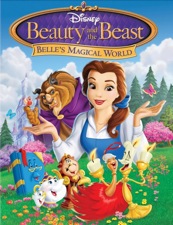 | ||
 |



